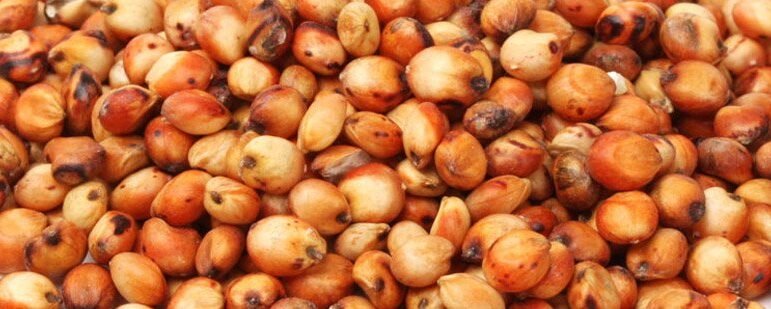SORGHUM

Commercial sorghum refers to the cultivation and commercial exploitation of species of grasses within the genus Sorghum (often S. bicolor). These plants are used for grain, fibre and fodder. The plants are cultivated in warmer climates worldwide. Commercial Sorghum species are native to tropical and subtropical regions of Africa and Asia.
Sorghum has been, for centuries, one of the most important staple foods for millions of poor rural people in the semiarid tropics of Asia and Africa. For some impoverished regions of the world, sorghum remains a principal source of energy, protein, vitamins and minerals. Sorghum grows in harsh environments where other crops do not grow well, just like other staple foods, such as cassava, that are common in impoverished regions of the world. It is usually grown without application of any fertilizers or other inputs by a multitude of small-holder farmers in many countries. Sorghum is used for food, fodder, and the production of alcoholic beverages. It is drought tolerant and heat tolerant, and is especially important in arid regions. It is an important food crop in Africa, Central America, and South Asia, and is the “fifth most important cereal crop grown in the world”.
In animal nutrition, grain sorghum is mostly used as an energy source and is a good feedstuff for poultry, pigs and ruminants. The stalks remaining after harvest can be grazed as some varieties stay green for a long period of time. Sorghum may also be grown for fodder, for grazing or cut green to make silage and hay.
Sorghum – Human Consumption:
Sorghum is a genus of herbaceous plants of the family Poaceae (grass) which includes about twenty species of temperate and warm climates plants. Many of them are grown as forage or as cereals for human consumption. Sorghum grains color varies from white and pale yellow to deep red, purple and brown, white, bronze and brown. Grain sorghum (Sorghum bicolor L. Moench) is considered to be one of the four most important cereal grains used for human consumption. While sorghum is considered to be native to tropical Africa and continues to be a leading cereal grain the most areas of the continent. Now it has huge source in India.
The color of the sorghum grain may be white, yellow, red, or brown. Certified food grade sorghum varieties are white but red has been recently developed for food use as well. Sorghum is higher in protein and lower in fat than corn. The mineral composition differs only slightly from corn, and the vitamin content in grain sorghum is similar to white corn.
Sorghum is sometimes referred to as kafir, kafir corn, durra, Milo, maize, Egyptian corn, African millet, Black Indian millet and pearl millet. The grain is an excellent food source when ground into flour and used to make pancakes, cake, pap, pancake Creole, porridge and flat breads. Sorghum is now used in a variety of recipes found online and in cookbooks, especially for people who are looking for gluten-free diet. Some recipes for which Sorghum is used include muffins, breads, pizzas, pasta dishes, cookies, cakes, and pies.
Some of the health benefits of sorghum include its ability to prevent certain types of cancer, help control diabetes, offer a dietary option for people with Celiac disease, improve digestive health, build strong bones, promote red blood cell development, and boost energy and fuel production.
Specification of Sorghum:
| Moisture | 14% Max. |
| Purity | 99% Min. |
| Insects | No insects dead or alive, vermin or excrement |
| Appearance | White, Red |
| Usage | Human consumption, Animal Feed & bird feed |
| Crop | New crop |
| Packing | New 50 kg PP bag or in bulk |
| Ability | 100 MT Per Month |
Container of Sorghum:
| Type Of Container | Quantity |
|---|---|
| 20′Fcl | 24 MT |
Why Sorghum From Kinal Global Care Private Limited?
- Transparent Written and Oral Communication about the product.
- Customer focused rather than sales focused.
- Experience of Shipping to almost 16 countries.
- Customers feedback for each shipment.
- Stringent Sourcing and Quality checking.
- Live Videos and Photos while processing.
- Willingness to help without any sales expectation.
- Direct Personal Involvement of Management in each shipment.
How To Select A Genuine Exporter Of Sorghum ?
- Understand Exporter’s Company and the Industry.
- Understand the Exporter’s Presence and experience.
- Knowledge, Quality and Source of the Product.
- Pricing of the Product.
- Willingness to help without any sales expectation.
- Video Calling/Physical Visit.
- Verification in Google about the complaints.
- Tradeshow Participation.
The countries which are importing Sorghum from India are:
 Kenya
Kenya Sudan
Sudan Djibouti
Djibouti Pakistan
Pakistan Saudi Arabia
Saudi Arabia
 Egypt
Egypt Taiwan
Taiwan UAE
UAE



